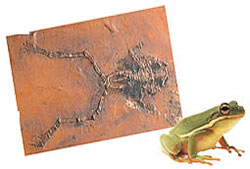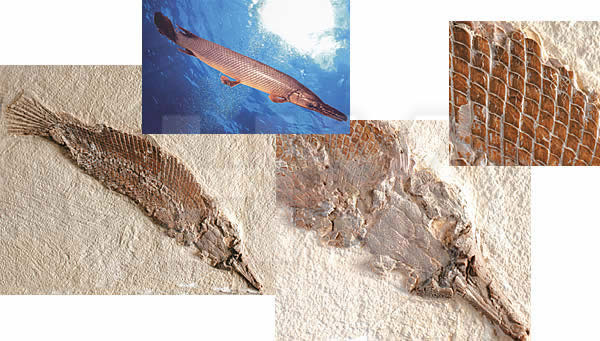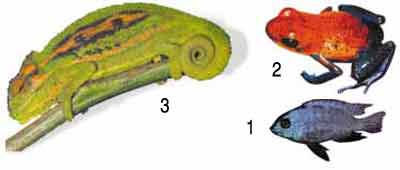Fish and Amphibians
Fish and amphibians emerged on the Earth suddenly and without any predecessors. Evolutionists cannot explain the origin of either of these living classes.
Evolutionists assume that the sea invertebrates that appeared in the Cambrian stratum somehow evolved into fish over tens of millions of years. However, there is not a single transitional link indicating that evolution occurred between these invertebrates and fish. Actually, the evolution of invertebrates that have their hard tissues outside their bodies and no skeleton into bony fish that have theirs in the middle of their bodies is a very big transformation which should have left a great number of transitional links.
 |
A fossil dating back 280 million years belonging to an extinct frog species. These discoveries reveal that frogs appeared suddenly on the Earth without any predecessors. |
Evolutionists have been digging fossil strata for about 140 years looking for these hypothetical forms. They have found millions of invertebrate fossils and millions of fish fossils; yet nobody has ever found even one that is midway between them.
An evolutionist paleontologist, Gerald T. Todd, asks the following questions in the face of this fact:
All three subdivisions of the bony fishes first appear in the fossil record at approximately the same time… How did they originate? What allowed them to diverge so widely?.. And why is there no trace of earlier, intermediate forms?26
The evolutionary scenario also argues that fish, which evolved from invertebrates, later transformed themselves into amphibians which are able to live on land. (Amphibians are animals capable of living both on land and in water, such as frogs.) But as you would imagine, this scenario also lacks evidence. There is not even a single fossil verifying that a half-fish/half-amphibian creature has ever existed. This fact is confirmed, albeit reluctantly, by a well-known evolutionist authority, Robert L. Carroll, who is the author of Vertebrate Paleontology and Evolution: "We have no intermediate fossils between rhipidistian fish and early amphibians."27
In short, both fish and amphibians emerged suddenly and in their present form without any predecessors. In other words, God created them in a perfect form.
 |
There is no difference between the fossil fish of hundreds of millions of years ago and modern fish. Fish have been created as fish and always remained so. |
 | One of the important contradictions in the fanciful evolutionary scheme stretching from fish to reptiles is the skin formation of these organisms. All fish have scales on their skin while amphibians do not. Reptiles that have allegedly evolved from amphibians also have scales. If we suppose that there is an evolutionary relationship between these organisms, we also have to answer why scales, which exist in fish, disappeared in amphibians, and then re-appeared in reptiles. Evolutionists, however, are unable to answer this question. |
THE PROBLEM OF SCALE 1. Fish, 2. Amphibian, 3. Reptile |
 |
THE MIRACLE OF METAMORPHOSIS Frogs are first born in water, live there for a while, and then emerge on to land in a process known as "metamorphosis." Some people think that metamorphosis is evidence of evolution, whereas, the two have actually nothing to do with one another. The sole development mechanism proposed by evolution is mutation. Metamorphosis does not come about by coincidental effects as mutation does. On the contrary, this change results from the frogs' genetic code. In other words, it is already evident that when a frog is first born, it will have a type of body allowing it to live on land. The evolutionists' claim of passage from water to land says that fish, with a genetic code completely designed to allow them to live in water, turned into land creatures as a result of chance mutations. But for this reason, metamorphosis actually tears evolution down, rather than shoring it up. Because the slightest error in the process of metamorphosis means the creature will die or be deformed. It is essential that metamorphosis should happen perfectly. It is impossible for such a complex process, which allows no room for error, to have come about by chance mutations, as is claimed by evolution. Metamorphosis is actually a miracle that reveals the perfection in creation. 1. The frog offspring hatching from its egg is a fish-like organism designed to live in water prior to metamorphosis. It takes in oxygen through gills just as fish do. Frogs at this stage are called "tadpoles". 2. The offspring that will emerge from the fertilized frog eggs will be plentiful enough to cover a lake or a flowing river. 3. With metamorphosis, frogs alter in form. At the end of a perfect transformation, they become adapted to live on land. |
Footnotes
25) David Raup, "Conflicts Between Darwin and Paleontology", Bulletin, Field Museum of Natural History, Band 50, Januar 1979, S. 24
26) Gerald T. Todd, "Evolution of the Lung and the Origin of Bony Fishes: A Casual Relationship", American Zoologist, Band 26, No. 4, 1980, S. 757
27) R. L. Carroll, Vertebrate Paleontology and Evolution, New York: W. H. Freeman and Co. 1988, S. 4.
- An Outdated View: The Theory of Evolution
- The Origin of Life
- The Design in the Protein
- The Design in the Cell
- Genetic Information
- The Design in Nature
- Miller's Experiment
- The Natural Selection Misconception
- Mutations
- Irreducible Complexity
- Impasse of Intermediate Forms
- The Cambrian Period
- Fish and Amphibians
- Coelacanth Misconception
- Reptiles
- Birds and Reptiles
- Archaeopteryx Misconception
- Bird Feathers
- The Origin of Mammals
- Living Fossils
- The Tale of Man's Evolution
- Australopithecus
- Homo Erectus
- A Lost Human Race: Neanderthals
- The Collapse of the Family Tree
- The Bipedalism Impasse
- False Faces
- Piltdown Scandal
- Why is Evolution Defended?
- The Obvious Truth: Creation
